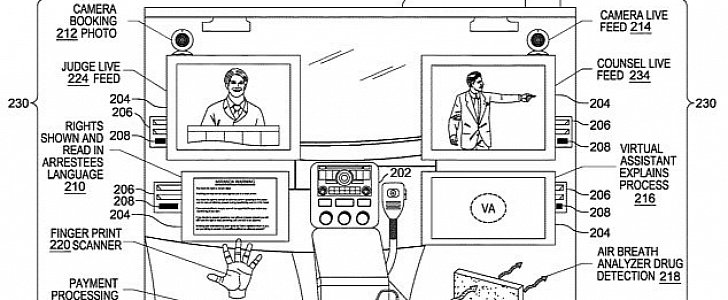Here’s a name you probably wouldn’t have guessed you’d hear thrown around in a conversation on driverless cars: Motorola. Earlier this month, Motorola took out a patent on a self-driving car that does all the work an actual, flesh-and-bone cop would do.
The idea is to develop a car so smart that not only could it drive itself, but could also arrest, process and take perpetrators to jail. In the patent filing, the company mentions that this vehicle would be used only in minor crimes, freeing police officers from doing all the work and allowing them to focus on more important cases.
The car would be equipped with devices that would allow proper and instant communication between authorities, and the detainee and his legal representative. For instance, after identifying the suspect and reading him his rights, the car would conduct a search on his person. Should it uncover illegal substances, it would communicate with a judge, who would, in turn, issue a search warrant on the suspect’s home or vehicle.
“The ability to have search warrants approved while the detainee is located in the vehicle saves considerable time and minimizes disruption in preserving evidence,” the document reads.
The car would be able to photograph the suspect and search for him in various databases, and include devices that would allow the suspect to swipe his credit card to pay fines, should one be necessary on the occasion. The suspect could also pay his own bail inside the vehicle. Once payment goes through, the car unlocks and he is a free man.
If the suspect needs to be taken to the police station, the car will do so. On the way, it would allow the suspect to contact his legal representative – either by phone or video conference. By the time the suspect arrives to jail, he will have been processed.
“By performing law enforcement processes and proceedings within a vehicular environment, an officer is able to remain in the field, thereby advantageously preserving law enforcement resources,” Motorola says in the patent filing.
If this sounds like something from sci-fi movies, don’t freak out just yet. As we all know, taking out a patent on something doesn’t mean it will happen tomorrow, or next year, or even 5 years from now. What it does mean, though, is that Motorola now has a dog in the self-driving race.
The car would be equipped with devices that would allow proper and instant communication between authorities, and the detainee and his legal representative. For instance, after identifying the suspect and reading him his rights, the car would conduct a search on his person. Should it uncover illegal substances, it would communicate with a judge, who would, in turn, issue a search warrant on the suspect’s home or vehicle.
“The ability to have search warrants approved while the detainee is located in the vehicle saves considerable time and minimizes disruption in preserving evidence,” the document reads.
The car would be able to photograph the suspect and search for him in various databases, and include devices that would allow the suspect to swipe his credit card to pay fines, should one be necessary on the occasion. The suspect could also pay his own bail inside the vehicle. Once payment goes through, the car unlocks and he is a free man.
If the suspect needs to be taken to the police station, the car will do so. On the way, it would allow the suspect to contact his legal representative – either by phone or video conference. By the time the suspect arrives to jail, he will have been processed.
“By performing law enforcement processes and proceedings within a vehicular environment, an officer is able to remain in the field, thereby advantageously preserving law enforcement resources,” Motorola says in the patent filing.
If this sounds like something from sci-fi movies, don’t freak out just yet. As we all know, taking out a patent on something doesn’t mean it will happen tomorrow, or next year, or even 5 years from now. What it does mean, though, is that Motorola now has a dog in the self-driving race.







